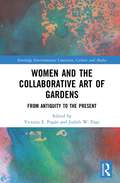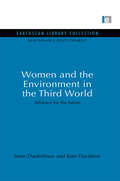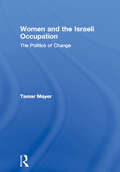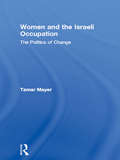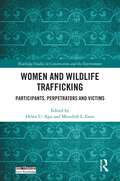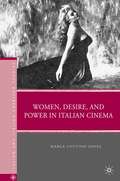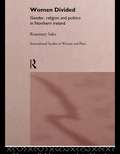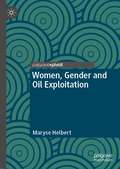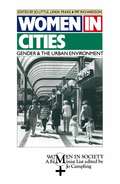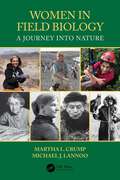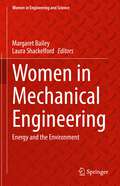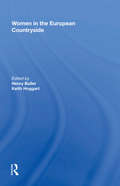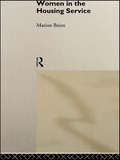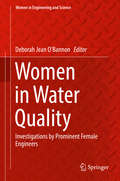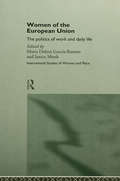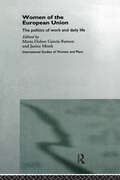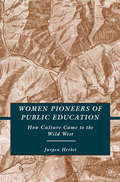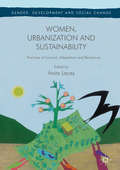- Table View
- List View
Women and the Collaborative Art of Gardens: From Antiquity to the Present (Routledge Environmental Literature, Culture and Media)
by Victoria E. Pagán Judith W. PageWomen and the Collaborative Art of Gardens explores the garden and its agency in the history of the built and natural environments, as evidenced in landscape architecture, literature, art, archaeology, history, photography, and film. Throughout the book, each chapter centers the act of collaboration, from garden clubs of the early twentieth century as powerful models of women’s leadership, to the more intimate partnerships between family members, to the delicate relationship between artist and subject. Women emerge in every chapter, whether as gardeners, designers, owners, writers, illustrators, photographers, filmmakers, or subjects, but the contributors to this dynamic collection unseat common assumptions about the role of women in gardens to make manifest the significant ways in which women write themselves into the accounts of garden design, practice, and history. The book reveals the power of gardens to shape human existence, even as humans shape gardens and their representations in a variety of media, including brilliantly illuminated manuscripts, intricately carved architectural spaces, wall paintings, black and white photographs, and wood cuts. Ultimately, the volume reveals that gardens are best apprehended when understood as products of collaboration. The book will be of interest to scholars and students of gardens and culture, ancient Rome, art history, British literature, medieval France, film studies, women’s studies, photography, African American Studies, and landscape architecture.
Women and the Collaborative Art of Gardens: From Antiquity to the Present (Routledge Environmental Literature, Culture and Media)
Women and the Collaborative Art of Gardens explores the garden and its agency in the history of the built and natural environments, as evidenced in landscape architecture, literature, art, archaeology, history, photography, and film. Throughout the book, each chapter centers the act of collaboration, from garden clubs of the early twentieth century as powerful models of women’s leadership, to the more intimate partnerships between family members, to the delicate relationship between artist and subject. Women emerge in every chapter, whether as gardeners, designers, owners, writers, illustrators, photographers, filmmakers, or subjects, but the contributors to this dynamic collection unseat common assumptions about the role of women in gardens to make manifest the significant ways in which women write themselves into the accounts of garden design, practice, and history. The book reveals the power of gardens to shape human existence, even as humans shape gardens and their representations in a variety of media, including brilliantly illuminated manuscripts, intricately carved architectural spaces, wall paintings, black and white photographs, and wood cuts. Ultimately, the volume reveals that gardens are best apprehended when understood as products of collaboration. The book will be of interest to scholars and students of gardens and culture, ancient Rome, art history, British literature, medieval France, film studies, women’s studies, photography, African American Studies, and landscape architecture.
Women and the Environment in the Third World: Alliance for the future (Sustainable Development Set)
by Irene Dankelman Joan Davidson'This book ... should be issued to grass-root organisations everywhere' Doris Lessing, The New Scientist 'It is must reading for government planners, environmentalists and the ordinary layman' Asia Week Women in the Third World play the major role in managing natural resources. They are also the first and hardest hit by environmental mismanagement, yet they are neither consulted nor taken into account by development strategists. lrene Dankelman and Joan Davidson provide a clear account of the problems faced by women in the management of land, water, forests, energy and human settlements. They also describe the lack of response from international organizations. With the help of well-documented case studies they describe the ways in which women can organize to meet environmental, social and economic challenges. Originally published in 1988
Women and the Environment in the Third World: Alliance for the future (Sustainable Development Set)
by Irene Dankelman Joan Davidson'This book ... should be issued to grass-root organisations everywhere' Doris Lessing, The New Scientist 'It is must reading for government planners, environmentalists and the ordinary layman' Asia Week Women in the Third World play the major role in managing natural resources. They are also the first and hardest hit by environmental mismanagement, yet they are neither consulted nor taken into account by development strategists. lrene Dankelman and Joan Davidson provide a clear account of the problems faced by women in the management of land, water, forests, energy and human settlements. They also describe the lack of response from international organizations. With the help of well-documented case studies they describe the ways in which women can organize to meet environmental, social and economic challenges. Originally published in 1988
Women and the Israeli Occupation: The Politics of Change (Routledge International Studies of Women and Place)
by Tamar MayerThe state of Israel and the Palestinian nation are at a monumental juncture in their histories. Both have a chance to claim a new future but more than a quarter of a century of occupation has had significant social, political, economic, cultural, psychological and moral ramifications for Israeli and Palestinian men and women.Women and the Israeli Occupation analyses the impact of the occupier/occupied dichotomy on the lives of Palestinian, Israeli Palestinian, and Israeli Jewish women. The book argues that the Occupation has exposed internal conflicts, challenging social structures within all three societies, but has also reinforced existing loyalties as Palestinian and Jewish women have moved into public political action and worked together to end the Occupation. It suggests that although military occupation is not colonialism, there are many similarities in the Israeli/Palestinian case.
Women and the Israeli Occupation: The Politics of Change (Routledge International Studies of Women and Place)
by Tamar MayerThe state of Israel and the Palestinian nation are at a monumental juncture in their histories. Both have a chance to claim a new future but more than a quarter of a century of occupation has had significant social, political, economic, cultural, psychological and moral ramifications for Israeli and Palestinian men and women.Women and the Israeli Occupation analyses the impact of the occupier/occupied dichotomy on the lives of Palestinian, Israeli Palestinian, and Israeli Jewish women. The book argues that the Occupation has exposed internal conflicts, challenging social structures within all three societies, but has also reinforced existing loyalties as Palestinian and Jewish women have moved into public political action and worked together to end the Occupation. It suggests that although military occupation is not colonialism, there are many similarities in the Israeli/Palestinian case.
Women and Wildlife Trafficking: Participants, Perpetrators and Victims (Routledge Studies in Conservation and the Environment)
by Helen U. AguThis volume examines women and wildlife trafficking via a bespoke collection of narratives, case studies and theoretical syntheses from diverse voices and disciplines. Wildlife trafficking has been documented in over one hundred and twenty countries around the world. While species extinction and animal abuse are major problems, wildlife trafficking is also associated with corruption, national insecurity, spread of zoonotic disease, undercutting sustainable development investments and erosion of cultural resources among others. The role of women in wildlife trafficking has remained woefully under-addressed, with scientists and policymakers failing to consider the important causes and consequences of the gendered dimensions of wildlife trafficking. Although the roles of women in wildlife trafficking are mostly unknown, they are not unknowable. This volume helps fill this lacuna by examining the roles and experiences of women with case studies drawn from across the world, including Mexico, Cameroon, the Central African Republic, South Africa and Norway. Women can be wildlife trafficking preventors, perpetrators, and pawns; their roles in both facilitating wildlife trafficking are considered from both a supply and a demand viewpoint. The first half of the book assesses the state of science, offering four different perspectives on how women and wildlife trafficking can be studied or evaluated. The second half of the book profiles diverse case studies from around the world, offering context-specific insight about on-the-ground activities associated with women and wildlife trafficking. This book will be of great interest to students and scholars of wildlife crime, conservation, gender studies, green criminology and environmental law. It will also be of interest to NGOs and policymakers working to improve efficacy of efforts targeting wildlife crime, the illegal wildlife trade, and conservation more broadly.
Women and Wildlife Trafficking: Participants, Perpetrators and Victims (Routledge Studies in Conservation and the Environment)
by Helen U. Agu Meredith L. GoreThis volume examines women and wildlife trafficking via a bespoke collection of narratives, case studies and theoretical syntheses from diverse voices and disciplines. Wildlife trafficking has been documented in over one hundred and twenty countries around the world. While species extinction and animal abuse are major problems, wildlife trafficking is also associated with corruption, national insecurity, spread of zoonotic disease, undercutting sustainable development investments and erosion of cultural resources among others. The role of women in wildlife trafficking has remained woefully under-addressed, with scientists and policymakers failing to consider the important causes and consequences of the gendered dimensions of wildlife trafficking. Although the roles of women in wildlife trafficking are mostly unknown, they are not unknowable. This volume helps fill this lacuna by examining the roles and experiences of women with case studies drawn from across the world, including Mexico, Cameroon, the Central African Republic, South Africa and Norway. Women can be wildlife trafficking preventors, perpetrators, and pawns; their roles in both facilitating wildlife trafficking are considered from both a supply and a demand viewpoint. The first half of the book assesses the state of science, offering four different perspectives on how women and wildlife trafficking can be studied or evaluated. The second half of the book profiles diverse case studies from around the world, offering context-specific insight about on-the-ground activities associated with women and wildlife trafficking. This book will be of great interest to students and scholars of wildlife crime, conservation, gender studies, green criminology and environmental law. It will also be of interest to NGOs and policymakers working to improve efficacy of efforts targeting wildlife crime, the illegal wildlife trade, and conservation more broadly.
Women, Desire, and Power in Italian Cinema (Italian and Italian American Studies)
by M. Cottino-JonesWomen, Desire, and Power in Italian Cinema offers, for the first time in Italian Cinema criticism, a contextual study of the representation of women in twentieth-century Italian films. Marga Cottino-Jones argues that the ways women are depicted on screen reflects a subconscious "sexual conservatism" typical of an Italian society rooted within a patriarchal ideology. The book then follows the slow but constant process of social awareness in the Italian society through women in film, especially after the 1950s. Comprehensive in scope, this book analyzes the films of internationally known male and female directors, such as Antonioni, Fellini, Rossellini, Visconti, Bertolucci, Benigni, Cavani, Wertmuller, Comencini, and Archibugi. Special consideration is given to the actresses and actors that have become the icons of Italian femininity and masculinity, such as Sofia Loren, Gina Lollobrigida, Silvana Mangano, Gian Carlo Giannini, Marcello Mastroianni, and Alberto Sordi.
Women Divided: Gender, Religion and Politics in Northern Ireland (Routledge International Studies of Women and Place)
by Rosemary SalesThe ongoing Irish peace process has renewed interest in the current social and political problems of Northern Ireland. In bringing together the issues of gender and inequality, Women Divided, a title in the International Studies of Women and Place series, offers new perspectives on women's rights and contemporary political issues. Women Divided argues that religious and political sectarianism in Northern Ireland has subordinated women. A historical review is followed by an analysis of the contemporary scene-- state, market (particularly employment patterns), family and church--and the role of women's movements. The book concludes with an in-depth critique of the current peace process and its implications for women's rights in Northern Ireland, arguing that women's rights must be a central element in any agenda for peace and reconciliation.
Women Divided: Gender, Religion and Politics in Northern Ireland (Routledge International Studies of Women and Place)
by Rosemary SalesThe ongoing Irish peace process has renewed interest in the current social and political problems of Northern Ireland. In bringing together the issues of gender and inequality, Women Divided, a title in the International Studies of Women and Place series, offers new perspectives on women's rights and contemporary political issues. Women Divided argues that religious and political sectarianism in Northern Ireland has subordinated women. A historical review is followed by an analysis of the contemporary scene-- state, market (particularly employment patterns), family and church--and the role of women's movements. The book concludes with an in-depth critique of the current peace process and its implications for women's rights in Northern Ireland, arguing that women's rights must be a central element in any agenda for peace and reconciliation.
Women, Gender and Oil Exploitation (Gender, Development and Social Change)
by Maryse HelbertThis book examines the gender dimensions of large-scale mining in the oil industry and how oil exploitation has produced long-term economic, political, social and environmental risks and benefits in developing countries. It also shows that these risks and benefits have been unequally distributed between women and men. This project maps the ongoing dialogue between women’s issues and resource management, particularly, oil. The author attempts to answer the following questions: What are the impacts of oil projects on women in oil-rich countries? How can these impacts be explained? How can these impacts be reduced?
Women in Cities: Gender and the Urban Environment (Women in Society: A Feminist List)
...a readable, thorough and stimulating introduction to this subject.' Critical Social Policy
Women in Field Biology: A Journey into Nature
by Martha L. Crump Michael J. LannooWomen are contributing to disciplines once the sole domain of men. Field biology has been no different. The history of women field biologists, embedded in a history largely made and recorded by men, has never been written. Compilations of biographies have been assembled, but the narrative—their story—has never been told. In part, this is because many expressed their passion for nature as writers, artists, collectors, and educators during eras when women were excluded from the male-centric world of natural history and science. The history of women field biologists is intertwined with men’s changing views of female intellect and with increasing educational opportunities available to women. Given the preponderance of today’s professional female ecologists, animal behaviorists, systematists, conservation biologists, wildlife biologists, restoration ecologists, and natural historians, it is time to tell this story—the challenges and hardships they faced and still face, and the prominent role they have played and increasingly play in understanding our natural world. For a broader perspective, we profile selected European women field biologists, but our primary focus is the journey of women field biologists in North America. Each woman highlighted here followed a unique path. For some, personal wealth facilitated their work; some worked alongside their husbands. Many served as invisible assistants to men, receiving little or no recognition. Others were mavericks who carried out pioneering studies and whose published works are still read and valued today. All served as inspiration and proved to the women who would follow that women are as capable as men at studying nature in nature. Their legacy lives on today. The 75 female field biologists interviewed for this book are further testament that women have the intellect, stamina, and passion for fieldwork.
Women in Field Biology: A Journey into Nature
by Martha L. Crump Michael J. LannooWomen are contributing to disciplines once the sole domain of men. Field biology has been no different. The history of women field biologists, embedded in a history largely made and recorded by men, has never been written. Compilations of biographies have been assembled, but the narrative—their story—has never been told. In part, this is because many expressed their passion for nature as writers, artists, collectors, and educators during eras when women were excluded from the male-centric world of natural history and science. The history of women field biologists is intertwined with men’s changing views of female intellect and with increasing educational opportunities available to women. Given the preponderance of today’s professional female ecologists, animal behaviorists, systematists, conservation biologists, wildlife biologists, restoration ecologists, and natural historians, it is time to tell this story—the challenges and hardships they faced and still face, and the prominent role they have played and increasingly play in understanding our natural world. For a broader perspective, we profile selected European women field biologists, but our primary focus is the journey of women field biologists in North America. Each woman highlighted here followed a unique path. For some, personal wealth facilitated their work; some worked alongside their husbands. Many served as invisible assistants to men, receiving little or no recognition. Others were mavericks who carried out pioneering studies and whose published works are still read and valued today. All served as inspiration and proved to the women who would follow that women are as capable as men at studying nature in nature. Their legacy lives on today. The 75 female field biologists interviewed for this book are further testament that women have the intellect, stamina, and passion for fieldwork.
Women in Mechanical Engineering: Energy and the Environment (Women in Engineering and Science)
by Margaret Bailey Laura ShackelfordThis book features influential scholarly research and technical contributions, professional trajectories, disciplinary shifts, personal insights, and a combination of these from a group of remarkable women within mechanical engineering. Combined, these chapters tell an important story about the dynamic field of mechanical engineering in the areas of energy and the environment, as seen from the perspective of some of its most extraordinary women scientists and engineers. The volume shares with the Women in Engineering and Science Series the primary aim of documenting and raising awareness of the valuable, multi-faceted contributions of women engineers and scientists, past and present, to these areas. Women in mechanical engineering and energy and the environment are historically relevant and continue to lead these fields as passionate risk takers, entrepreneurs, innovators, educators, and researchers. Chapter authors are members of the National Academies, winners of major awards and recognition that include Presidential Medals, as well as SWE, SAE, ASME, ASEE and IEEE Award winners and Fellows.
Women in the European Countryside
by Henry BullerMuch of the literature published so far on gender relations in rural areas has either focused on comparisons of the position of men and women, or explored the position of women given prevailing structural forces and behavioural 'norms' that restrict the autonomy of women as human agents. This groundbreaking book broadens the debate by developing our understanding of how societal processes produce and sustain gender divisions, particularly in rural areas, highlighting aspects of rural women's lives previously invisible in the literature. Illustrated by case studies from France, Germany, Greece, Norway and Sweden, the book examines the critical issues of education and training, entrepreneurship, leadership, limited work and service opportunities, social mobility, and work experiences. In doing so, the contributors provide a fascinating comparative study of both national-regional and broader European realities.
Women in the European Countryside
by Henry BullerMuch of the literature published so far on gender relations in rural areas has either focused on comparisons of the position of men and women, or explored the position of women given prevailing structural forces and behavioural 'norms' that restrict the autonomy of women as human agents. This groundbreaking book broadens the debate by developing our understanding of how societal processes produce and sustain gender divisions, particularly in rural areas, highlighting aspects of rural women's lives previously invisible in the literature. Illustrated by case studies from France, Germany, Greece, Norway and Sweden, the book examines the critical issues of education and training, entrepreneurship, leadership, limited work and service opportunities, social mobility, and work experiences. In doing so, the contributors provide a fascinating comparative study of both national-regional and broader European realities.
Women in the Housing Service
by Marion BrionThis book explores the contribution of women to the development of housing management in the 20th century. It outlines tactics and strategies of organization and factors which have seemed to help or hinder women's participation in housing. Evidence from statistical sources, historical documents and personal interviews is also assessed. Throughout the discussion, key issues are linked to current trends in the 1990s, making this volume suitable as a source of reference for students and researchers in housing and related fields.
Women in the Housing Service
by Marion BrionThis book explores the contribution of women to the development of housing management in the 20th century. It outlines tactics and strategies of organization and factors which have seemed to help or hinder women's participation in housing. Evidence from statistical sources, historical documents and personal interviews is also assessed. Throughout the discussion, key issues are linked to current trends in the 1990s, making this volume suitable as a source of reference for students and researchers in housing and related fields.
Women in Water Quality: Investigations by Prominent Female Engineers (Women in Engineering and Science)
by Deborah Jean O’BannonThis volume captures the impact of women’s research on the public health and environmental engineering profession. The volume is written as a scholarly text to demonstrate that women compete successfully in the field, dating back to 1873. Each authors’ chapter includes a section on her contribution to the field and a biography written for a general audience. This volume also includes a significant representation of early women’s contributions, highlighting their rich history in the profession. The book covers topics such as drinking water and health, biologically-active compounds, wastewater management, and biofilms. This volume should be of interest to academics, researchers, consulting engineering offices, and engineering societies while also inspiring young women to persist in STEM studies and aspire to academic careers.Features a blend of innovations and contributions made by women in water quality engineering, as well as their path to success, including challenges in their journeysPresents an opportunity to learn about the breadth and depth of the field of water qualityIncludes a history of women in water quality engineering as well as research in current issues such as urban water quality, biologically-active compounds, and biofilms
Women of the European Union: The Politics of Work and Daily Life (Routledge International Studies of Women and Place)
by Maria Dolors Garcia-Ramon Janice MonkWomen of the European Union challenges gender-blind assessments of the economic and social aspects of the European Union policies to examine the real implications of Union for the diversity of women in the Member States.The authors also analyze how women's work and daily lives are shaped by local and national policies, by local and global economic conditions, and by diverse and changing cultural values.Detailed contemporary case studies explore how place comes together with class, life stage, sexuality and ethnicity to affect the way in which women are constrained and how they develop strategies to manage their lives.
Women of the European Union: The Politics of Work and Daily Life (Routledge International Studies of Women and Place)
by Maria Dolors García-Ramon Janice MonkWomen of the European Union challenges gender-blind assessments of the economic and social aspects of the European Union policies to examine the real implications of Union for the diversity of women in the Member States.The authors also analyze how women's work and daily lives are shaped by local and national policies, by local and global economic conditions, and by diverse and changing cultural values.Detailed contemporary case studies explore how place comes together with class, life stage, sexuality and ethnicity to affect the way in which women are constrained and how they develop strategies to manage their lives.
Women Pioneers of Public Education: How Culture Came to the Wild West
by J. HerbstThe book narrates the story of how the school, founded by women pioneers of public education in a Rocky Mountain mining settlement, became the centre and sustaining force of the town's community life from its beginning in the 1870s to the present day.
Women, Urbanization and Sustainability: Practices of Survival, Adaptation and Resistance (Gender, Development and Social Change)
by Anita LaceyThis work considers the city as a gendered space and examines women’s experiences and engagement in both urbanization and sustainability. Such a focus offers distinctive insights into the question of what it means for a city to be sustainable, asking further how sustainability needs to work with gender and the gendered lives of cities’ inhabitants. Vitally, it considers women’s lives in cities and their work to forge more sustainable cities through a wide variety of means, including governmental, non-governmental and local grassroots and individual efforts towards sustainable urban life. The volume is transnational, offering case-studies from a wide range of city sites and sustainability efforts. It explores crucial questions such as the gendered nature and women’s experiences of current urbanization; the gendered nature of urban sustainability thinking and programmes; and local alternatives and resistances to dominant modes of addressing urbanization challenges.
